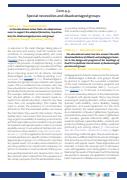Core 4.3. Special necessities and disadvantaged groups ITEM 4.3.1 Educational Center In the educational center there are adopted mea- sures to support the adapted formation, in particu- larly the disadvantaged persons and groups Completely / Enough / Something / Nothing In response to the rapid changes taking place in the economy and society, Dual VET systems must contribute to increasing employability and social inclusion. The European quality assurance systems (EQAVET) place a special emphasis on the need to support the provision of adapted training, in parti- cular to disadvantaged groups, as evidenced in their quality indicators (4,5,6,8 and 10 ). In addition, it is about improving access for all citizens, including disadvantaged people, to lifelong learning. [one. European. See: EQAVET P8, P10]. Disadvantaged in- dividuals and groups include students with special needs. This is considered to be someone who may have educational needs that cannot be met throu- gh standard instructional and assessment practices (for example, behavioral, communication, intellec- tual, physical, gifted, or other student needs ex- ceptions for special education; students may have more than one exceptionality). This implies the need to ensure the existence of communication channels so that the interested parties can receive the information they need for their activity. The lea- dership team must ensure that resources and trai- ning support accessibility in learning environments; and that reasonable accommodations are provided for students with special needs in order to promote equitable access to educational facilities and envi- ronments as other students. [See: ISO 21001:2018 – Section 5.1.3] In the regulations for dual VT projects in Andalusia there is no specific mention of disadvan- taged people or groups, nor of those who may have any special needs. It is a reality whose attention po- ses many problems for centers and companies. At- tention to diversity in Dual Vocational Training is an area pending treatment and development. One of the practical options raised from the experience of the centers proposes that the administration drawup a precise catalog of those disablities that could be incorporated into certain cycles. [4. Autonomous: Order of January 18, 2021, which calls for dual professional training projects for the 2021/2022 academic year. BOJA, Number 18 - Thurs- day, January 28, 2021. Link]. ITEM 4.3.2 Educational Center The educational center has into account the addi- tional mediations of didactic and pedagogic charac- ter in the design and program of the teachings of Dual PF to facilitate the inclusion of disadvantaged persons and groups Completely / Enough / Something / Nothing Pedagogical and didactic measures for the inclusion of disadvantaged individuals and groups should be planned to support the successful completion of the Dual Professional Formative programs and the acquisition of job-related skills [1. European. See: EQAVET P4]. To this end, it is necessary to ca- rry out an exhaustive analysis of the characteristics of students with special needs. These may include screening for reading disorders, written expression disorder, math disability, motor disability, hearing impairment, and visual impairment. For the most gifted students, the needs assessment may inclu- de consideration of levels of giftedness, hyperlexia, and preliminary assessment for areas of giftedness (for example, general intellectual ability, specific academic aptitude, leadership ability, creativity and productive thinking, psychomotor ability, visual and performing arts among others) [2. International. See: ISO 21001:2018 – Section 8.2.1 Note 3]. Regar- ding teaching methodologies, the educational cen- ter should use differentiated instructional strategies that allow the use of recommended approaches for students with special needs. These approaches are intended to foster the development of self-aware- ness, self-regulation, and metacognition. It is about balancing the needs of the student with the training requirements. Likewise, the application of individua- lized measures in a flexible way is recommended,
